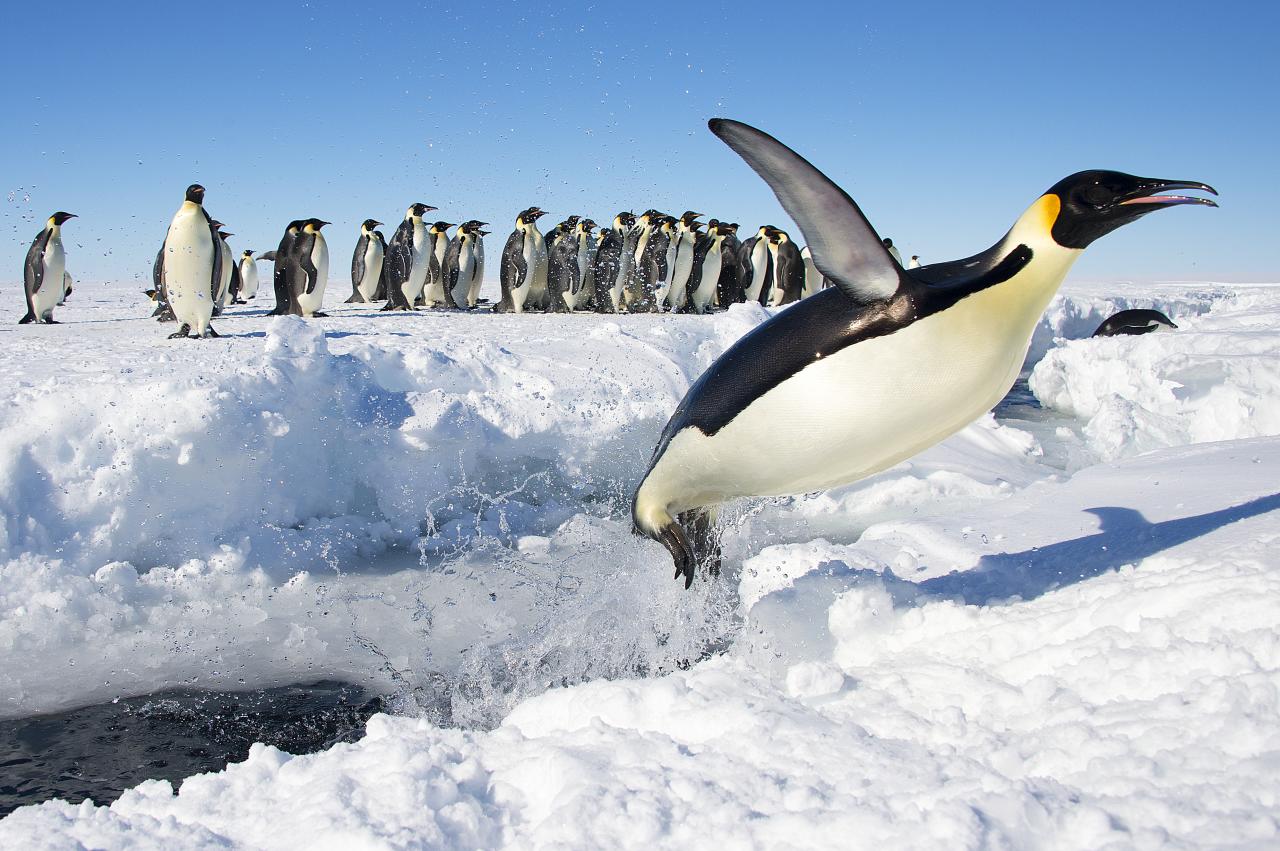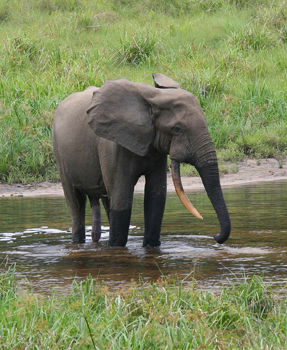10.2: Measures of Biodiversity Loss
- Page ID
- 37204
The Red List
The International Union for the Conservation of Nature (IUCN) coordinates efforts to catalog and preserve biodiversity worldwide. One way scientists gauge trends in biodiversity is by monitoring the fate of individual species. Since 1964, the IUCN has compiled information in the Red List of Threatened Species, which includes plants, animals, fungi, and selected brown algae species. Updates to the Red List are released every four years.
Species can be classified into nine Red List categories based on their extinction risk. Firstly, there are species that are already extinct and those that are extinct in the wild, meaning that the remaining individuals are only found in captivity. Species at risk of extinction are called threatened. Species that are at risk of becoming threatened are called near threatened. The Emperor Penguin (Aptenodytes forsteri) is an example a near threatened species, mainly due to habitat loss and climate change (figure \(\PageIndex{a}\)). Those with little risk of extinction are designated least concern. Note that only a fraction of the 8-11 million species on Earth are identified (see The Number of Species on Earth). For many of the species that are identified, data still needs to be gathered before they can be assigned to a Red List category (data deficient). Less than 10% of the approximately 1.5 million identified species have been assessed for the Red List at all. Species that have not been assessed are deemed not evaluated.

There are three categories of threatened species: vulnerable, endangered, and critically endangered. Of these, critically endangered species have the greatest risk while vulnerable species are at the least risk out of the threatened categories. The African elephant (Loxodonta africana) is listed vulnerable species due to poaching and habitat loss (figure \(\PageIndex{b}\)). Interestingly, the forest subspecies (L. africana cylotis) is at much greater risk than the savanna subspecies (L. africana africana), but the Red List category is assigned at the species level in this case. The blue whale (Balaenoptera musculus) is endangered due to pollution, climate change, and poaching (figure \(\PageIndex{c}\)). Fortunately, blue whale population size is increasing. Several species of pitcher plants, which trap insects as a source of nitrogen, are critically endangered due to overexploitation and habitat loss (figure \(\PageIndex{d}\)).



Extinct and Threatened Animals
Scientists know much more about the state of vertebrates—especially mammals, birds, and amphibians—than they do about other forms of animal life. Of 6,594 described mammal species, 96 species have become extinct during the last 500 years (Mammal Diversity Database). According to the Red List, approximately 26% of mammal species worldwide are known to be threatened. A smaller percentage (about 14%) of the world's 10,721 identified bird species (Birds of the World) are threatened (figure \(\PageIndex{e}\)).

Among the well-studied vertebrates, amphibians are faring especially poorly. Of the more than 6,000 known species of amphibians, 35 have become extinct worldwide since 1500 (figure \(\PageIndex{f}\)), and two others are extinct in the wild (Red List). Overall, 41% of the world's amphibian species are known to be threatened (Red List). Only small proportions of the world's species of reptiles and fish have been evaluated for purposes of the Red List. Among those, 34% of selected reptiles and 8% of selected bony fishes are threatented (Red List).

Invertebrates comprise the vast majority of animals, an estimated 97% of animal species. They include everything from insects and arachnids, to mollusks, crustaceans, corals, and more. Few of these groups have been assessed in a comprehensive way, but assessments within some groups call attention to disturbing, large-scale trends. For example, 33% of the world's reef-building corals are already considered threatened (Red List), and many more of them are experiencing rates of decline that move them toward threatened status (figure \(\PageIndex{g}\)). The demise of reef-building corals has magnified ecological impacts, since so much other marine life depends on them.

Ecosystem Loss and Alteration
Another way of gauging biodiversity involves assessment on the scale of ecosystems. The causes of wholesale losses of ecosystems are much the same as those driving extinction or endangerment of species, with habitat destruction and fragmentation being the primary agent. Worldwide, for example, the conversion of land to agriculture and cultivation have led to significant losses in grassland ecosystems. In North America, nearly 70% of the tallgrass prairie ecosystem (which once covered 142 million acres) has been converted to agriculture, and losses from other causes, such as urban development, have brought the total to about 90%. Current estimates indicate that agricultural activity and cultivation systems now cover nearly 25% of the Earth's surface
According to the United Nations Millennium Ecosystem Assessment, by the beginning of the 21st century, 15 of the world’s 24 ecosystems, from rainforests to aquifers to fisheries, were rated in serious decline. For example, tropical rainforests, which are the habitats for nearly half of the world's plant and animal species, covered about 4 billion acres in past centuries, but only 2.5 billion acres remain and nearly 1% is being lost annually. Losses have been especially severe in the tropics of Africa and Southeast Asia. Current estimates indicate that about 50% of the world's wetland habitat has been lost. (Note that wetlands are a broad collection of many different ecosytem types.) The former extent of wetland habitats worldwide (fresh, brackish and salt) is difficult to determine but certainly exceeded a billion acres.
References
Birds of the World. 2020. The Cornell Lab of Ornithology. Accessed 2020-07-29.
The IUCN Red List of Threatened Species. 2020. IUCN. Accessed 2020-07-29.
Mammal Diversity Database. 2020. American Society of Mammalogists. Accessed 2020-07-29.
Attribution
Modified by Melissa Ha from Biodiversity, Species Loss, and Ecosystem Function and The Industrialization of Nature: A Modern History (1500 to the present) from Sustainability: A Comprehensive Foundation by Tom Theis and Jonathan Tomkin, Editors. Download for free at CNX. (licensed under CC-BY)


